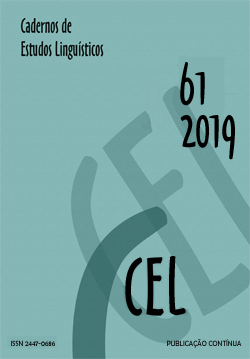Abstract
Formulaic language, such as phrasal verbs, can be defined as a prefabricated sequence of words. Phrasal verbs comprised a particle and a verb which present literal and figurative meanings. In the present study we investigated the online processing of figurative phrasal verbs (e.g. figure out) and lexical verbs (e.g. understand) by means of the eye-tracking. Eye movements of 12 advanced speakers of English as L2 (native speakers of Brazilian Portuguese) were compared to that of 12 native speakers of English during the reading of sentences containing figurative phrasal verbs and lexical verbs in English. The results show that on late measures (Total Reading Time), the speakers of English as L2 engendered more cognitive processing during the reading of figurative phrasal verbs than lexical verbs, compared to native speakers of English. These results were interpreted as evidence that the speakers of English as L2 tried to analyze each component of the figurative multiword item (e.g. look for) and this slowed down their processing. The results are discussed in the light of theories on the processing of figurative and literal language.
References
BIBER, D.; JOHANSSON, S.; LEECH, G.; CONRAD, S.; FINEGAN, E. Longman grammar of spoken and written English. Harlow, England: Longman, 1999.
BOBROW, S. A.; BELL, S. M. On catching on to idiomatic expressions. Memory and Cognition, v.1, n.3, p. 343-346, 1973.
CACCIARI, C.; TABOSSI, P. The comprehension of idioms. Journal of Memory and Language, v.27, p. 668-683, 1988.
CAPPELLE, B. Particle Patterns in English: a comprehensive coverage. Master’s thesis. Université Charles -de-Gaulle Lille 3, 2005.
CIEŚLICKA, A. Literal salience in on-line processing of idiomatic expressions by second language learners. Second Language Research. v.22, n.2, p. 115-144, 2006.
CIEŚLICKA, A.; HEREDIA, R.; OLIVARES, M. It’s all in the eyes: How language dominance, salience, and context affect eye movements during idiomatic language processing. In: ARONIN, L.; PAWLAK, M. (Eds.). Essential topics in applied linguistics and multilingualism: Studies in honor of David Singleton. Springer, 2014. p. 21-42.
ELLIS, N. C.; SIMPSON-VLACH, R.; MAYNARD, C. Formulaic Language in Native and Second Language Speakers: Psycholinguistics, Corpus Linguistics, and TESOL. TESOL Quarterly, v.42, n.3, p. 375-396, 2008.
ERMAN, B.; WARREN, B. The idiom principle and the open choice principle. Text, v.20, p. 29-62, 2000.
FOSTER, P. Rules and Routines: A consideration of their role in the task-based language production of native and non-native speakers. In: BYGATE, M.; SKEHAN, P.; SWAIN, M. (Eds.). Researching pedagogic tasks: Second Language Learning. Teaching and Testing. Harlow, UK: Longman, 2001. p. 75-93.
GIORA, R. Understanding figurative and literal language: The graded salience hypothesis. Cognitive Linguistics, v.8, n.3, p. 183-206, 1997.
GIORA, R. On the priority of salient meanings: studies of literal and figurative language. Journal of Pragmatics, v.31, p. 919–929, 1999.
GIORA, R. Literal vs. figurative language: Different or equal? Journal of Pragmatics, v.34, n.4, p. 487–506, 2002.
GIORA, R. On Our Mind: Salience, Context, and Figurative Language. University, I.R.G.P.L.T.A. Oxford University Press, USA. p. 272, 2003.
HOWARTH, P. The phraseology of learners’ academic writing. In: COWIE, A. (Ed.). Phraseology: Theory, analysis and applications. Oxford, UK: Oxford University Press, 1998. p. 161-186.
KECSKES, I. Is the idiom Principle Blocked in Bilingual L2 Production? In: HEREDIA, R. R.; CIEŚLICKA, A. B. (Eds.). Bilingual Figurative Language Processing. 1st ed. New York: Cambridge University Press, 2015. p. 28-52.
LITTLEMORE, J.; LOW, G. What is “Figurative Thinking”? In: LITTLEMORE, J.; LOW, G. (Eds.). Figurative Thinking and Foreign Language Learning. Palgrave Macmillan, 2006. p. 3-22.
MATLOCK, T.; HEREDIA, R. Understanding phrasal verbs in monolinguals and bilinguals. In: HEREDIA, R.R.; ALTARRIBA, J. (Eds.). Bilingual sentence processing. Elsevier, 2002. p. 251-274.
MITCHELL, D. On-line methods in Language Processing: Introduction and Historical review. In: CARREIRAS, M.; CLIFTON, Jr. C. (Eds.). The on-line study of sentence comprehension: Eye-tracking, ERPs and beyond. New York, NY: Psychology Press, 2004. p. 15-32.
NUNES, A. F. Noticing, Instrução e Produção Oral em L2: Um Estudo Experimental sobre os Verbos de Movimento. 2013. 149 f. Dissertação (Mestrado em Linguística Aplicada) – Departamento de Línguas Estrangeiras e Tradução da Universidade de Brasília, Brasília.
PAULMANN, S.; GHAREEB-ALI, Z.; FELSER, C. Neurophysiological Markers of Phrasal Verb Processing: Evidence from L1 and L2 Speakers. In: HEREDIA, R. R.; CIEŚLICKA, A. B. (Eds.). Bilingual Figurative Language Processing. 1st ed. New York: Cambridge University Press, 2015. p. 245-267.
PHRASAL VERBS DICTIONARY LONGMAN. New York, N. Y. Pearson Education, 2000.
RAYNER, K.; POLLATSEK, A. Eye-movement Control in Reading. In: Handbook of Psycholinguistic. Elsevier Inc., 2nd ed., 2006. p. 613-657.
ROBERTS, L.; SIYANOVA-CHANTURIA, A. Using eye-tracking to investigate topics in L2 acquisition and L2 sentence and discourse processing. Studies in Second Language Acquisition, v.35, n.2, p. 213-235, 2013.
SIYANOVA-CHANTURIA, A.; CONKLIN, K.; SCHMITT, N. Adding more fuel to the fire: An eye-tracking study of idiom processing by native and nonnative speakers. Second Language Research, v.27, p. 251-272, 2011.
STAUB, A.; RAYNER, K. Eye movements and on-line comprehension processes. In: GASKELL, M. G. (Ed.). The Oxford Handbook of Psycholinguistics, 2007. p. 327-342.
SWINNEY, D. A.; CUTLER, A. The Access and Processing of Idiomatic Expressions. Journal of Verbal Learning and Verbal Behavior, v.18, p. 523-534, 1979.
THIM, S. Phrasal Verbs: The English Verb-Particle Construction and its History (Topics in English Linguistics 78). Berlin and New York: De Gruyter Mouton, 2012.
TITONE, D.; CONNINE, C. On the compositional and noncompositional nature of idiomatic expressions. Journal of Pragmatics, v.31, p. 1655-1674, 1999.
WRAY, A. Formulaic Language and the Lexicon. Cambridge University Pres, 2002.

This work is licensed under a Creative Commons Attribution-NonCommercial 4.0 International License.
Copyright (c) 2019 Cadernos de Estudos Linguísticos


